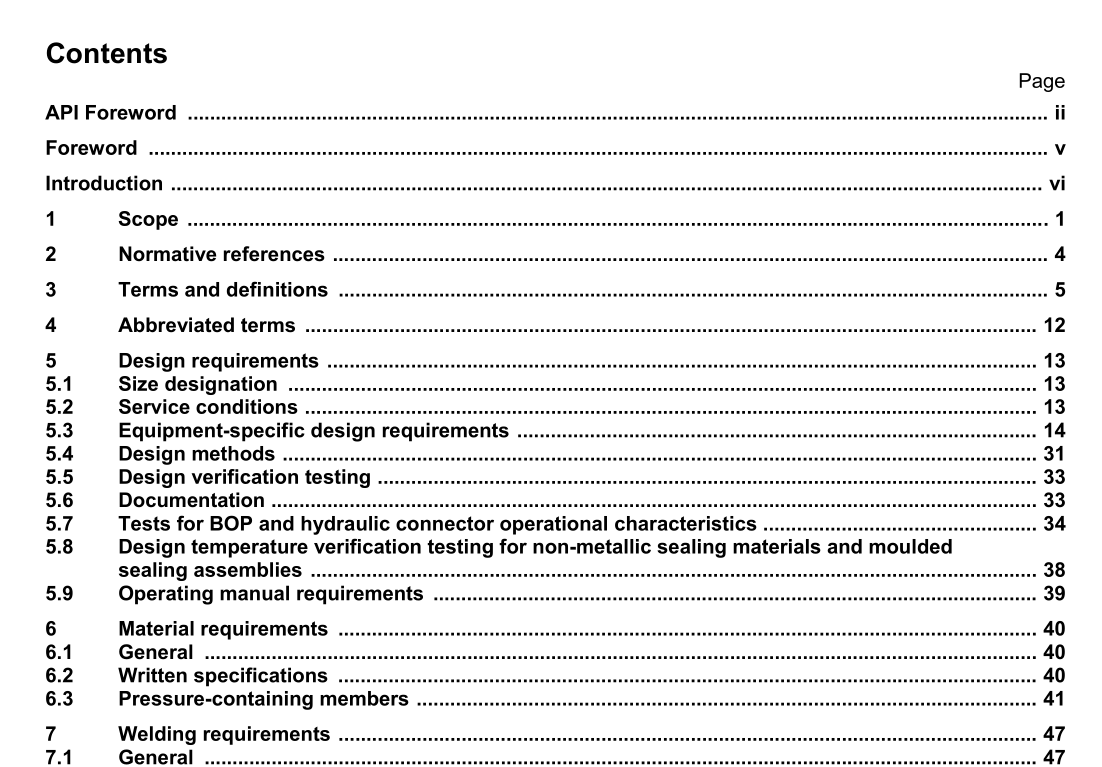ANSI API Spec 16A pdf download

ANSI API Spec 16A pdf download.Petroleum and natural gas industries — Drilling and production equipment — Drill-through equipment
3 Terms and definitions
For the purpose of this American National Standard, the following terms and definitions apply. 3.1 acceptance criteria defined limits placed on characteristics of materials, products or service 3.2 adapter pressure-containing piece of equipment having end connections of different nominal size designation and/or pressure rating 3.3 annular blowout preventer blowout preventer that uses a shaped elastomeric sealing element to seal the space between the tubular and the wellbore or an open hole 3.4 blind connection end or outlet connection with no centre bore, used to completely close off a connection 3.5 blind-shear ram closing and sealing component in a ram blowout preventer that first shears the tubular in the wellbore and then seals off the bore or acts as a blind ram if there is no tubular in the wellbore 3.6 blind ram closing and sealing component in a ram blowout preventer that seals the open wellbore 3.7 blowout preventer BOP equipment (or valve) installed at the wellhead to contain wellbore pressure either in the annular space between the casing and the tubulars or in an open hole during drilling, completion, testing or workover operations 3.8 body any portion of equipment between end connections, with or without internal parts, which contains wellbore pressure 3.9 bolting threaded fasteners used to join end or outlet connections 3.10 calibration comparison and adjustment to a standard of known accuracy 3.11 cast, verb pour molten metal into a mould to produce an object of desired shape 3.12 casting, noun object at or near finished shape obtained by solidification of a substance in a mould 3.13 chemical analysis determination of the chemical composition of material 3.14 clamp, noun device with internal angled shoulders used to fasten mating hubs 3.15 clamping load axial load applied to clamp hubs by the clamp due to bolt tightening 3.16 closure bolting threaded fasteners used to assemble pressure-containing parts other than end and outlet connections 3.17 conformance compliance with specified requirements in every detail 3.18 corrosion-resistant ring groove ring groove lined with metal resistant to metal-loss corrosion 3.19 critical component part having requirements specified in this American National Standard 3.20 data acquisition system system for storing and/or providing permanent copies of test information EXAMPLES Strip chart recorders, circular chart recorders or computer systems.3.21 date of manufacture date of the manufacturer’s final acceptance of finished equipment 3.22 drilling spool pressure-containing piece of equipment having end connections, used below or between drill-through equipment NOTE When outlet connections are provided, they shall be manufactured in accordance with this American National Standard. 3.23 end connection flange (studded or open-face), hub connection or other end connection (3.47) used to join together equipment and integral to that equipment 3.24 equipment any single completed unit that can be used for its intended purpose without further processing or assembly 3.25 fabrication weld weld joining two or more parts 3.26 flange protruding rim, with holes to accept bolts and having a sealing mechanism, used to join pressure-containing equipment together by bolting to another flange 3.27 forge, verb plastically deform metal, usually hot, into desired shapes with compressive force, with open or closed dies 3.28 forging, noun shaped metal part formed by the forging method 3.29 full-penetration weld weld that extends throughout the complete wall section of the parts joined 3.30 gasket-seating load that portion of the clamping load required to seat the gasket and bring the hub faces into contact 3.31 gasket-retaining load that portion of the clamping load required to offset the separating force the gasket exerts on the hubs when pressurized 3.32 heat-affected zone HAZ that portion of the base metal which has not been melted, but whose mechanical properties or microstructure has been altered by the heat of welding or cutting 3.33 heat cast lot material originating from a final melt NOTE For remelted alloys, a heat is defined as the raw material originating from a single remelted ingot.









